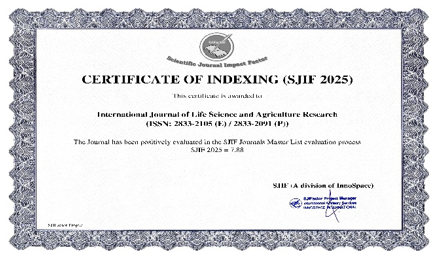Analysis of Trouble in Dry Land Management and Hills in Ngada District, East Nusa Tenggara Indonesia
DOI:
https://doi.org/10.55677/ijlsar/V03I7Y2024-06Keywords:
Dry Land, Agriculture, Management_Constraints, Ngada_DistrictAbstract
The district of Ngada is a high plain of hills and mountains with a very diverse topophysiography. There are some fertile areas, but there are also areas that are dry. In mountainous areas, crops such as coffee, coconut, strawberries, cocoa, and horticultural crops, food crops, and livestock. On dry land, it is difficult for plants to rejuvenate due to rainfall and water availability. Sustainable agriculture should be supported, in particular, with regard to the management of dry land in the region. The purpose of this research is to identify the obstacles that occur in dry land with a dry climate, so it is easier to find solutions to problems or obstacles occurring in the dry land and hills (hill area) of the district of Ngada. The research method used is a library approach by scanning and exploring several journals, books, and documents, as well as other sources of data or information considered relevant to the research. The results of the library show that there are some problems that often arise in the process of dry land management in the district of Ngada, namely the decline in soil fertility due to erosion and water laundering, very steep topography, water availability, and problems in production. Based on these obstacles, alternative solutions can be applied, such as using vegetative or mechanical soil management methods, increasing rainwater harvesting, managing water resources thoroughly, and growing drought-resistant crops.
References
Abdurachman, A. A., Dariah, and A. Mulyani. (2008). Dry land management strategies and technologies support national food procurement. Journal of Agriculture, 27 (2): 43–49.
Abbas, A. (2019). The Role of Islamic Marketing Ethics Towards Customer Satisfaction.
Abdurachman, A., Wahyunto, and R. Shofiyati, 2004. The idea of controlling the conversion of arable land in the framework of national food sustainability. Providing multifunctional seminars on agriculture and conservation of land resources Bogor, December 13, 2003.
Alim Nurmaranti, Marulam MT Simarmata Bambang Gunawan, Tioner Purba, Nirmala Juita Jajuk Herawati, Refa Firgiyanto, Junairiah, and Astrina Nur Inayah. (2022). Dry Land Management. Foundations We Write: Fields.
Arsyad, S. (2010). Land and Water Conservation, Second Edition, IPB Press, Bogor.
BPS NTT (2022). Statistics of Pertnian Ngada. Central Statistical Bureau of the Province of East Nusa Tenggara. Kupang.
Ceunfin S., Prajitno D., Suryanto P., Son of ETS, 2017. Assessment of competition and profit yields from soya corn under the white wood. Savana Cendana, 2 (1):1-3.
Harahap, F.S., Arman, I., Wicaksono, M., Mico, W.T., Rauf, A., and Walida, H. (2019). Provision of organic material on coconut slopes against soil chemical analysis. Agrica Ekstensia, 13(2), pp. 47–54.
Idjudin, A. A., & Marwanto, S. (2008). Reform of dry land management to support food security.
International Institute of Rural Reconstruction. (2002). Managing Dryland Managing Dryland Resources: A Manual for Eastern and Southern Africa.
Juhadi. (2007). Patterns of land use and environmental degradation in mountainous areas. Semarang: Department of Geography, Faculty of Social Sciences, State University of Semarang.
Notohadinegoro, T. (2000). Physical and chemical diagnosis of land damage Asmendep I Habitat/Bapedal. 1-3 July 1999: Yogyakarta.
Noywuli, N., Sapei, A., Pandjaitan, NH., and Eriyatno. (2018). Sustainability assessment on watershed management in the Aesesa Flores Watershed, East Nusa Tenggara Province of Indonesia. Journal of Sustainability Science and Management (JSSM)-Malaysia, Vol. 13, No. 2.
Noywuli, N., Sapei, A., Pandjaitan, NH., and Eriyatno. (2019). Assessment of watershed carrying capacity for the Aesesa Flores Watershed Management, East Nusa Tenggara Province of Indonesia. Environment and Natural Resources Journal (ENRJ)—Thailand, Vol. 17, No. 2.
Noywuli, N. (2020). Sustainable River Flow Area Management Policy Model Study; Aesesa Flores DAS Case Study. CV publisher: Amerta Media, Banyumas.
Noywuli, A. (2023). Approaches to Conservation in Agriculture Management. ISSN: 2985-7074; 2: 16–27.
Land and Agroclimate Research Center, 1993. Technical Guidelines and Land Evaluation. National Agricultural Research and Development Project, Agriculture Research and Development Agency, 38.
Sitorus, A., Sitoros, B., & Sepiring, M. (2018). Survey of Soil Fertility on Agriculture Land in Subdistrict Lumban Julu, District Toba Samosir. Journal of Agroecology, 6(2), 225–230.
Solowey, E. M., Amede, T., Evans, A., Boelee, E., & Bindraban, P. (2013). Chapter 6: Drylands.
Wawan. (2017). The Organic Material Management Teaching Book. University of Riau.
Downloads
Published
Issue
Section
License
Copyright (c) 2024 International Journal of Life Science and Agriculture Research

This work is licensed under a Creative Commons Attribution 4.0 International License.












